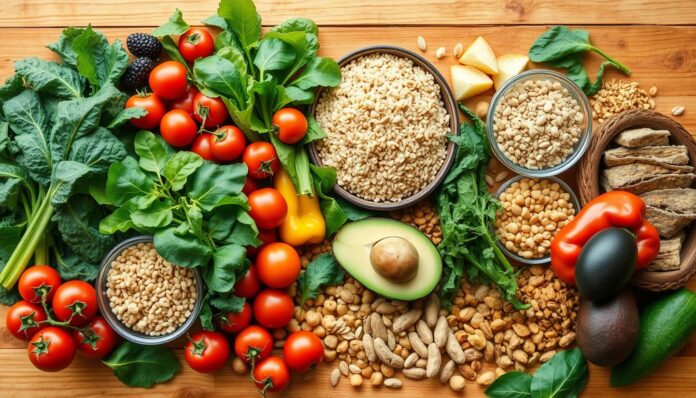Living with type 2 diabetes means you need to watch what you eat closely. The right foods can help keep your blood sugar in check. A good diet plan is key to staying healthy.
It’s important to find a diet that fits you well. Eating foods that are balanced, low in sugar, and high in fiber is a good start. This can help manage your blood sugar and lower your risk of serious problems.
With a diet plan made just for you, you can make better food choices. This helps you develop habits that are good for your health over time. Knowing how diet affects type 2 diabetes lets you take charge of your health and feel better overall.
Table of Contents
Key Takeaways
- A well-planned type 2 diabetes diet plan is essential to managing your condition
- The best diet for type 2 diabetes is rich in nutrients, low in added sugars, and high in fiber
- A balanced diet can help you control your blood sugar levels and reduce your risk of complications
- A type 2 diabetes diet plan should be tailored to your individual needs and preferences
- By focusing on healthy foods and developing good eating habits, you can improve your overall health and wellbeing
Understanding the Link Between Diet and Type 2 Diabetes
Managing type 2 diabetes starts with what you eat. Foods for diabetes management are key. By choosing wisely, you can keep your blood sugar in check. Healthy eating for diabetes means more than just avoiding some foods. It’s about knowing how different foods affect you.
Exploring foods for diabetes management shows carbs’ big impact on blood sugar. It’s important to balance carbs to keep blood sugar stable. Also, when you eat matters, as it helps control blood sugar and avoid sudden spikes.
How Food Affects Your Blood Sugar Levels
Here are some key points for healthy eating for diabetes:
- Choose complex carbohydrates, such as whole grains, fruits, and vegetables, which are rich in fiber and nutrients.
- Incorporate lean protein sources, like poultry, fish, and legumes, into your meals.
- Healthy fats, such as those found in nuts, seeds, and avocados, can help regulate blood sugar levels.
The Role of Carbohydrates in Blood Sugar Management
Carbohydrates are crucial in a healthy eating for diabetes plan. Learning to balance carbs helps keep blood sugar stable and prevents spikes.
Why Timing Your Meals Matters
When it comes to foods for diabetes management, meal timing is key. Eating regular, balanced meals helps control blood sugar and prevents spikes. By making smart choices about what and when you eat, you can manage your diabetes and live a healthy life.
The Best Diet for Type 2 Diabetes: Core Principles
Managing diabetes with diet means focusing on whole foods, less sugar, and more fiber. This helps you create a meal plan that fits your lifestyle and health goals. By following these principles, you can make a diet plan that works for you.
A key part of a diabetes-friendly diet is balance and variety. This means eating a wide range of foods. For example:
- Whole grains, like brown rice and whole-wheat bread
- Non-starchy vegetables, like broccoli and leafy greens
- Lean proteins, like chicken and fish
- Healthy fats, like avocado and nuts
By eating these foods, you build a healthy and balanced diet. Managing diabetes with diet is a long-term effort. It requires patience, dedication, and a willingness to change your lifestyle. With the right approach, you can manage your blood sugar and maintain a healthy weight.
By following these core principles and making a personalized meal plan, you can manage your diabetes better. A diabetes-friendly diet is not a one-size-fits-all solution. It’s a flexible plan that can be tailored to your needs. With the right guidance, you can create a diet that helps you reach your health goals.
Foods That Help Control Blood Sugar
Managing type 2 diabetes means focusing on low glycemic foods. These foods help keep blood sugar levels stable. A good balanced diet for type 2 diabetes includes a mix of foods that are nutritious and won’t raise blood sugar too much.
Non-Starchy Vegetables to Include
Vegetables like broccoli, spinach, and bell peppers are full of fiber and antioxidants. They’re great for a balanced diet for type 2 diabetes. Plus, they’re low glycemic foods, so they won’t cause a big jump in blood sugar.
Lean Proteins for Blood Sugar Stability
Lean proteins like chicken, turkey, and fish help control blood sugar. They also make you feel full. Adding these proteins to your meals can help keep your blood sugar stable and prevent spikes.
Other foods that help control blood sugar include:
- Healthy fats like avocados and nuts
- Fiber-rich foods like whole grains and legumes
Foods to Limit or Avoid
Managing type 2 diabetes means watching what you eat. Nutrition tips for type 2 diabetes tell us to avoid foods that raise blood sugar. These include sugary drinks, refined carbs, and saturated fats.
Reading food labels is key to making smart choices. Nutrition tips for type 2 diabetes suggest eating whole, unprocessed foods. Here are some foods to limit or avoid:
- Sugary drinks, such as soda and sports drinks
- Refined carbohydrates, such as white bread and sugary snacks
- Saturated fats, such as those found in processed meats and full-fat dairy products
By following these nutrition tips for type 2 diabetes, you can lower your risk of complications. And manage your condition well.
Creating Your Diabetes-Friendly Meal Plan
To manage type 2 diabetes, it’s key to follow a best diet for type 2 diabetes. This diet helps keep blood sugar levels in check. A good type 2 diabetes diet plan can greatly help control the condition. Start your meal plan with a balanced breakfast that includes protein, healthy fats, and complex carbs.
A healthy breakfast helps keep your blood sugar stable all day. Good breakfast choices are oatmeal with fruits and nuts, scrambled eggs with whole-grain toast, or Greek yogurt with berries and honey. For lunch and dinner, eat whole, unprocessed foods like veggies, lean proteins, and whole grains. Smart snacking can also help manage blood sugar.
- Choose whole, unprocessed foods whenever possible
- Incorporate a variety of colorful vegetables into your meals
- Opt for lean protein sources like poultry, fish, and legumes
- Limit your intake of added sugars and saturated fats
By following these tips and making a personalized type 2 diabetes diet plan, you can manage your condition better. Also, keep a healthy weight. Always talk to a healthcare professional or registered dietitian to make a meal plan that fits your needs and lifestyle.
Tips for Eating Out and Special Occasions
Managing your blood sugar levels is key, even when you’re out or at special events. A few simple changes can help you enjoy social gatherings while keeping your diabetes in check.
Restaurant Navigation Strategies
When looking at restaurant menus, choose foods high in nutrients and low in added sugars, salt, and unhealthy fats. Opt for grilled chicken, fish, and veggies. Feel free to ask for modifications, like less sauce or a smaller portion.
Holiday and Party Planning
Holidays and parties often tempt us with sweet treats and rich foods. But, with some planning, you can enjoy the fun while making healthy choices. Bring a dish like a fruit salad or raw veggies with hummus to share.
- Choose smaller portions of high-carb foods
- Opt for water or unsweetened tea instead of sugary drinks
- Take a walk after eating to help regulate your blood sugar levels
By following these tips, you can enjoy eating out and special occasions. You’ll manage your blood sugar levels and prioritize foods for diabetes management.
Conclusion: Making Your Diabetes Diet Work for You
Congratulations on starting to manage your type 2 diabetes with a healthy diet. By following the tips in this article, you can control your blood sugar. This can also lower your risk of diabetes-related problems.
Creating a diabetes-friendly diet is a journey that’s unique to you. What works for you might not work for others. Be patient and find the right mix of foods and portion sizes that make you feel great.
Keep working hard to make managing diabetes with diet a long-term goal. Having a support system, like your healthcare team or family, is key. Their help and encouragement can greatly support your journey to better health.
With the right mindset and meal planning, you can make your diabetes diet successful. Enjoy the positive changes and celebrate your achievements. Your health and well-being are worth all the effort.
FAQ
What is the best diet for type 2 diabetes?
For type 2 diabetes, eat foods that are full of nutrients but low in added sugars and refined carbs. Foods high in fiber are also key. This diet helps control blood sugar, keeps weight healthy, and lowers the risk of diabetes problems.
What are the core principles of a diabetes-friendly diet?
A good diet for diabetes focuses on whole foods. It limits added sugars and refined carbs. Include lots of non-starchy veggies, lean proteins, and healthy fats.
Eat foods high in fiber to keep blood sugar stable. Plan your meals and snacks to manage blood sugar levels.
What are some of the best foods for managing type 2 diabetes?
Good foods for type 2 diabetes include non-starchy veggies like broccoli and spinach. Choose lean proteins like chicken and fish, and healthy fats like avocado.
Include fiber-rich foods like whole grains and berries. Low-glycemic fruits like berries and apples are also good.
What foods should I limit or avoid on a type 2 diabetes diet?
Avoid sugary foods and drinks, like soda and candy. Refined carbs, such as white bread, are also bad. Fried foods and too much alcohol are off-limits.
Limiting these foods helps control blood sugar and reduces diabetes risks.
How can I create a balanced meal plan for type 2 diabetes?
For a balanced meal plan, add non-starchy veggies to every meal. Choose lean proteins and healthy fats. Include fiber-rich carbs like whole grains and legumes.
Time your meals and snacks to keep blood sugar stable. Practice portion control and tailor your plan to your needs and lifestyle.
How can I make healthy choices when eating out or at special events?
At restaurants or events, research menus for diabetes-friendly options. Ask about food preparation and ask for changes if needed.
Focus on veggies, lean proteins, and healthy fats. Avoid sugary drinks and fried foods. Bring healthy snacks if you can. Pay attention to portion sizes and listen to your hunger and fullness.
Main Reference: Diet for Type 2 Diabetes in Adults



























